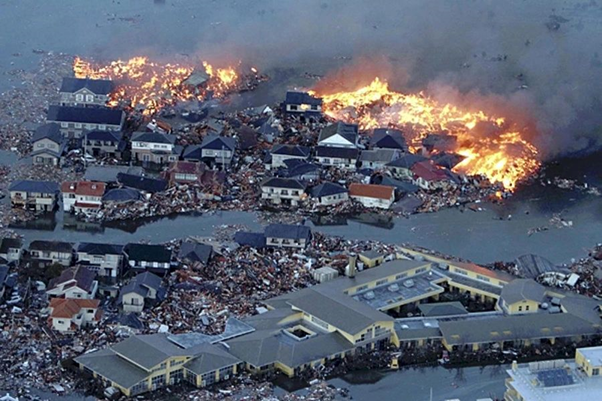Humans build cities on the surface of the earth, but not every city is built on a stable geological environment.

In cities that are commonly affected by earthquakes, how are buildings affected, in what form are infrastructures destroyed, how do earthquake-resistant buildings work, and how do we repair cities after earthquakes.
Earthquake damage
First, the extent of earthquake damage depends on the magnitude of the earthquake and the distance between the city and the epicenter, and the vertical depth is also taken into consideration. Earthquakes can cause land movement, causing direct physical damage to buildings and roads, and even cracking of the land in severe cases. The geological characteristics of the city will also affect the damage caused by earthquakes. For example, if the city is near a mountain or on a mountain, the rockfall and landslides caused by the earthquake will cause secondary damage in different ways. The underground rivers and soil structures under the city may cause land liquefaction during an earthquake. In addition, the different structures of houses will also affect the damage caused by earthquakes to the city. Cities near the sea may also face more terrible associated disasters such as tsunamis.
Forms of damage caused by earthquakes:
Physical shaking and land tearing
Rockfall
Soil liquefaction
Landslides
Tsunamis
Fires caused by building damage
The relationship between earthquake damage and building types
The materials used in buildings and even the building form will have different effects on resisting earthquake damage.
Total damaged buildings in ten districts of the city of Rasht due to 1990 Manjil earthquake (Bahrainy 1992) https://link.springer.com/chapter/10.1007/978-3-031-08321-1_3#citeas
The picture shows the damage to buildings after the Manjir earthquake in northwestern Iran on June 20, 1990, but it is clear that the extent of damage to buildings is not completely distributed according to the distance from the earthquake center. Different regions have different materials and different forms of construction methods, which in turn affect the impact of buildings when an earthquake strikes.
Earthquake-resistant buildings
Large-scale construction projects such as bridges and tunnels have earthquake-resistant design requirements from the beginning, but different bridge configurations and materials used will also affect the earthquake resistance of bridges.
In countries such as Japan, which have rich experience in earthquake resistance, they often use wood as a building material, because wood can be very flexible at a low cost. This makes it easy to promote it in large quantities in residential buildings. And in many building structures, diagonal bracing structures are widely used to share the instantaneous lateral loads generated in earthquakes. In addition, there are many new damping structures that have been tried in the past decade. Dampers are added to the components of the building to achieve the purpose of absorbing earthquake energy.
In addition to passive energy absorption, some experimental buildings use hydraulics and computer sensors to adjust the movable structure under the building in real time to reduce the damage to the building structure caused by the earthquake force.
In addition to buildings, for all means of transportation, such as high-speed railways, quick stopping during an earthquake is also a means of ensuring safety.


Earthquake-resistant structurehttps://www.bbc.com/future/article/20190114-how-japans-skyscrapers-are-built-to-survive-earthquakes
Earthquakes not only cause damage to houses, but also affect almost all roads and railways within a certain range
The Kyushu highway in April 2016 https://www.bbc.com/future/article/20190114-how-japans-skyscrapers-are-built-to-survive-earthquakes
Generally speaking, when a city encounters an earthquake, it is very difficult to save itself with only its own personnel and resources, so external rescue work becomes very important. However, since the damage caused by earthquakes to cities includes these infrastructures, generally speaking, whether the roads entering the city are convenient to use after an earthquake has a very important impact on the rescue work. After the Mangil earthquake in northwestern Iran on June 20, 1990, landslides and rolling stones were the main sources of road damage. Bridges and tunnels will also be affected, and for some cities that rely on bridges and tunnels to connect to the outside world, the damage to them is tantamount to cutting off the lifeline of a city.
Damage caused by earthquakes
The damage caused by earthquakes to people can take different forms. Small earthquakes, but the huge tsunamis they cause may also cause great damage. If someone happens to be in an open area during a huge earthquake, he will most likely survive. (If there is no huge crack under his feet) A collapsed building may not cause much damage because the building materials themselves are light. If a person stands in an earthquake-resistant building but does not face the earthquake in the correct posture, such as lying on a table, he may also suffer damage, but this is not the focus of this article.
Post-earthquake reconstruction
Earthquakes can cause damage to cities, but in the process of post-disaster reconstruction, how to ensure that a city can avoid decline due to the damage caused by the earthquake is a very important goal.
Liu (2014) On May 12, 2008, an 8.0 magnitude earthquake occurred in Sichuan Province. Due to the loss of a large amount of arable land and the destruction of most industrial facilities in Weizhou Town, how to promote economic development became the key issue of the town.

New spatial structures in Weizhou Town. (Source: authors’drawing based on fieldwork in 2013 and an existing map of Weizhou Town.) https://www.researchgate.net/publication/259120749_Urban_design_for_post-earthquake_reconstruction_A_case_study_of_Wenchuan_County_China
After meeting the earthquake-resistant upgrade requirements of the original infrastructure and buildings, the reconstruction project also re-analyzed and redesigned the city.
After using some urban ruins to complete some memorial urban landscape designs, it was decided to carry out some tourism designs with the cooperation of local government policies under the consideration of economic foundation, which met the urban revitalization after the earthquake. Earthquakes are not only a kind of destruction to cities, but also an opportunity to renew cities. Use reconstruction to optimize some roads that were originally inconvenient in cities.
Earthquakes are undoubtedly a disaster for people in cities, but as urban designers, we need to carry out some preventive designs before the disaster. But after the disaster, we should not only think about the physical repair of urban buildings and roads, but also the economic repair. Cities are not only buildings, but also the people and environment inside.
Reference list
Henriques, M. (2019). How Japan’s skyscrapers are built to survive earthquakes. [online] BBC. Available at: https://www.bbc.com/future/article/20190114-how-japans-skyscrapers-are-built-to-survive-earthquakes.
Bahrainy, H., Bakhtiar, A. (2022). Manjil Earthquake of June 20, 1990, The Lessons Learned. In: Urban Design in Seismic-Prone Regions. The Urban Book Series. Springer, Cham. https://doi.org/10.1007/978-3-031-08321-1_3
Liu, L., Lin, Y. and Wang, S. (2014). Urban design for post-earthquake reconstruction: A case study of Wenchuan County, China. Habitat International, 41, pp.290–299. doi:https://doi.org/10.1016/j.habitatint.2013.09.001.







